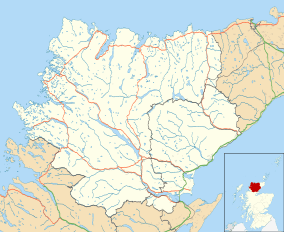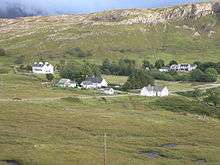Inchnadamph
Inchnadamph is a hamlet in Assynt, Sutherland, Scotland. The name is an anglicisation of the Gaelic name Innis nan Damh meaning 'meadow of the stags'.[1] Assynt is a remote area with a low population density and Inchnadamph contains a few houses, a lodge and a hotel.
Inchnadamph
| |
|---|---|
 Inchnadamph Location within the Sutherland area | |
| OS grid reference | NC251216 |
| • Edinburgh | 166 mi (267 km) |
| • London | 498 mi (801 km) |
| Council area | |
| Lieutenancy area | |
| Country | Scotland |
| Sovereign state | United Kingdom |
| Post town | LAIRG |
| Postcode district | IV27 |
| Dialling code | 01571 |
| Police | Scotland |
| Fire | Scottish |
| Ambulance | Scottish |
| UK Parliament | |
| Scottish Parliament |
|
History



The 'Bone Caves' of Inchnadamph contain relics of Eurasian lynx, brown bear, Arctic fox, reindeer (dated to 47,000 BCE), the only evidence of polar bears so far found in Scotland, and human skeletons dated to the 3rd millennium BCE.[2][3][4] The skeleton of a bear thought to be 11,000 years old or more was removed from the caves in 2008. The bones were found by cavers in 1995, deep in the Uamh an Claonaite system and have been examined by the National Museums Scotland to determine the age and species. It is presumed the animal died while hibernating, and that its body was later washed further into the underground network.[5]
The ruins of Ardvreck Castle lie nearby on the shores of Loch Assynt. The castle was badly damaged in a thunderstorm in 1795. The Old Parish Church of Assynt is located in the village and pieces of an old Celtic cross have been found, dating from the 8th to the 11th century.[6]
Geology
The Moine Thrust runs through the area, which is a mecca for geologists, who can find accommodation in the Assynt Field Centre (Inchnadamph Lodge) or at Inchnadamph Hotel. Nearby there is a monument to the work of Ben Peach and John Horne whose work was crucial in the understanding of this, the first thrust fault to be discovered anywhere in the world. The monument's inscription reads: "To Ben N Peach and John Horne who played the foremost part in unravelling the geological structure of the North West Highlands 1883-1897. An international tribute. Erected 1930". The hotel retains a copy of the guest book signed by many prominent geologists of the day who visited during the 1912 British Association for the Advancement of Science excursion to Assynt.[7]
References
- Iain Mac an Tailleir. "Placenames" (PDF). Pàrlamaid na h-Alba. Archived from the original (PDF) on 10 April 2008. Retrieved 8 September 2007.
- McKenzie, Steven (10 December 2007) New tests on rare polar bear find" Retrieved 29 July 2008. The original supposition was that this was the remains of a cave bear.
- Murray, W.H. (1977) The Companion Guide to the West Highlands of Scotland. London. Collins. Murray states the skeletons were dated to 6000 BC.
- "Inchnadamph Bone Caves " Archived 2 December 2008 at the Wayback Machine SNH Retrieved 29 July 2008. This source and McKenzie (2007) mentions dates of 4515 and 4720 BP for the human remains.
- Restan, Sue (29 July 2008) "Bear skeleton finally taken from cave in Sutherland". Aberdeen. The Press and Journal.
- "Inchnadamph Area List". Scotlandindex.net. Archived from the original on 7 September 2007. Retrieved 8 September 2007.
- Dryburgh, P.M. et al. (1995) Assynt: The Geologists' Mecca. Edinburgh Geological Society.